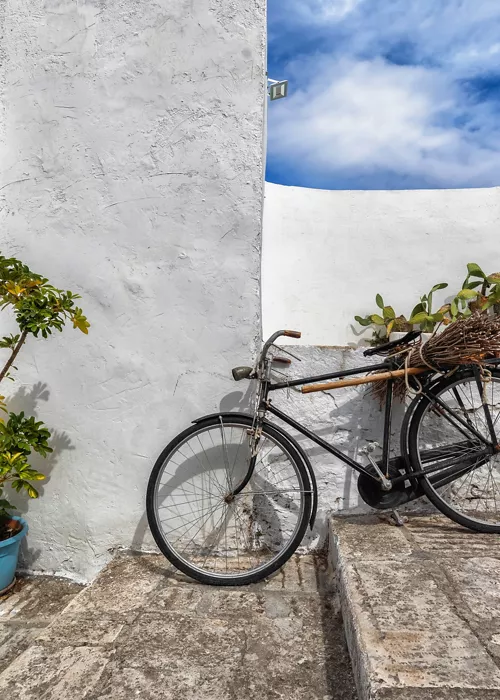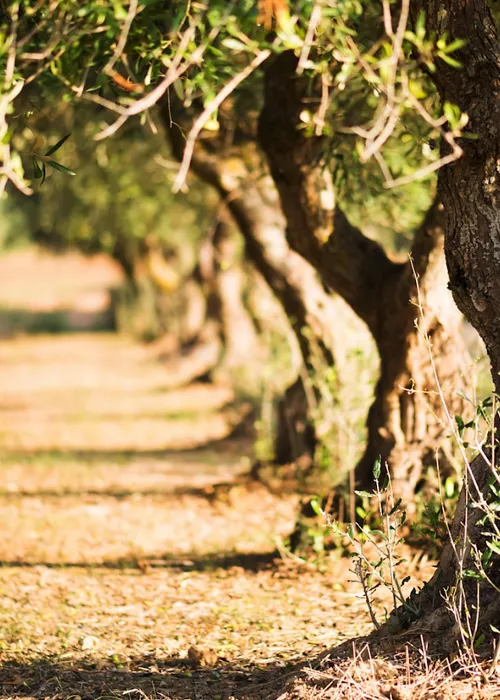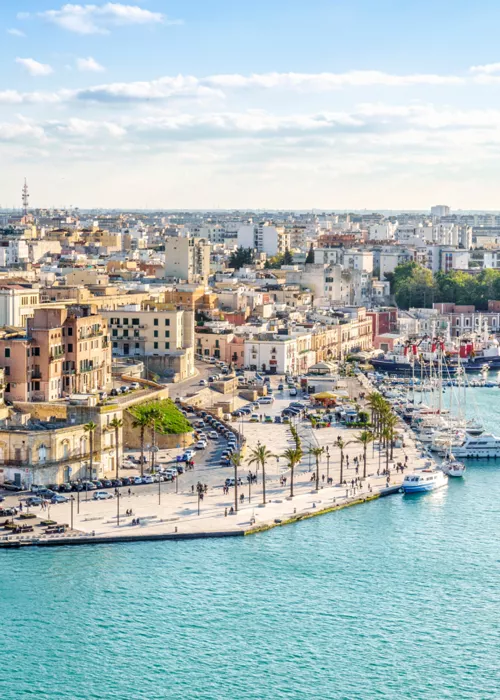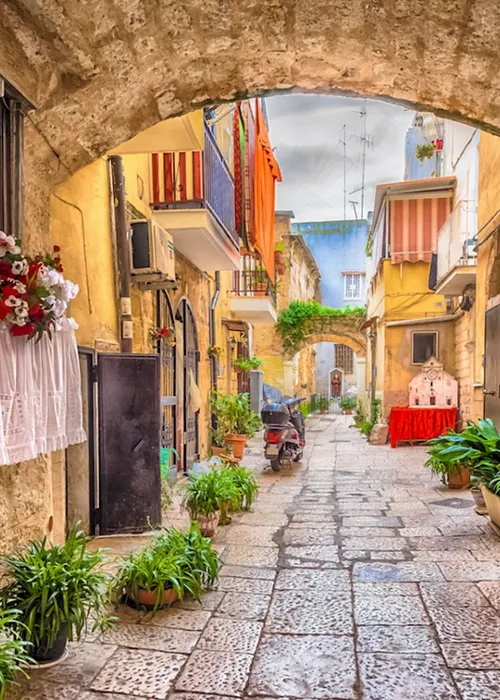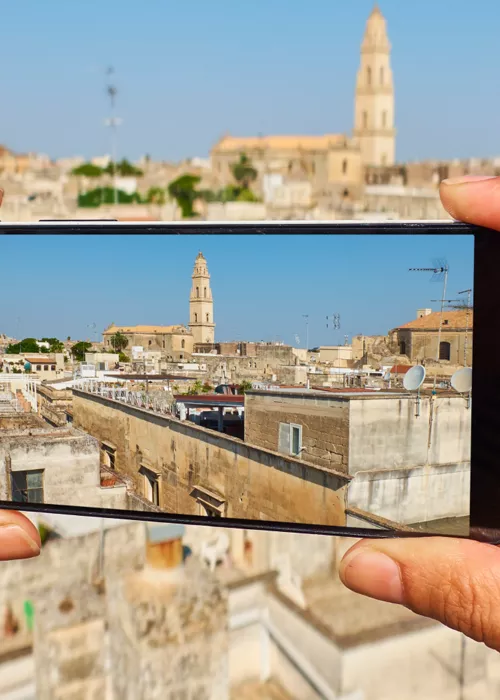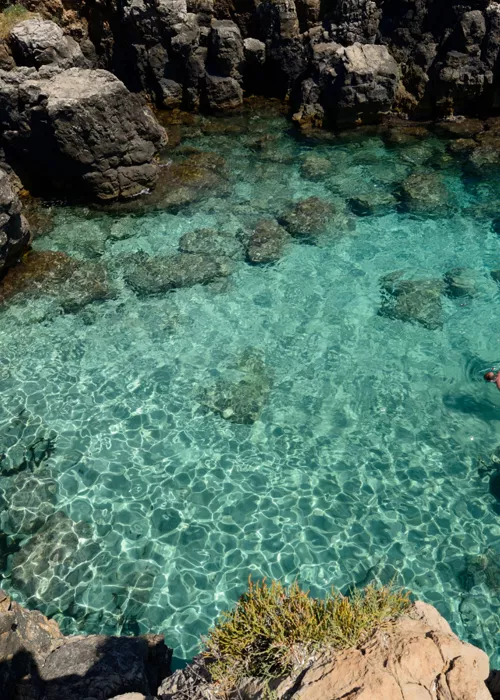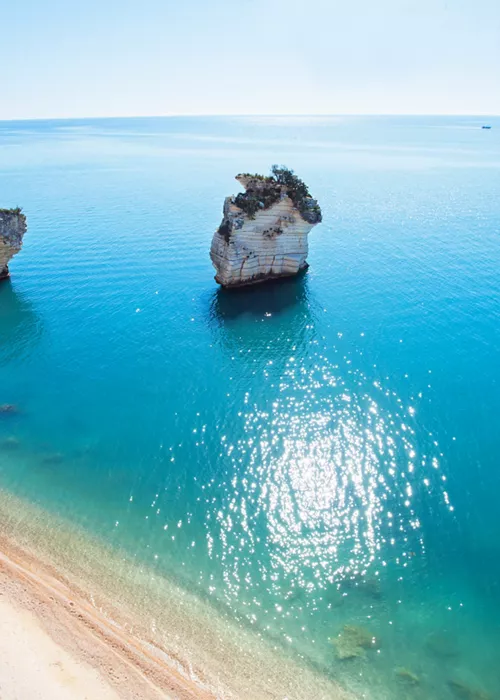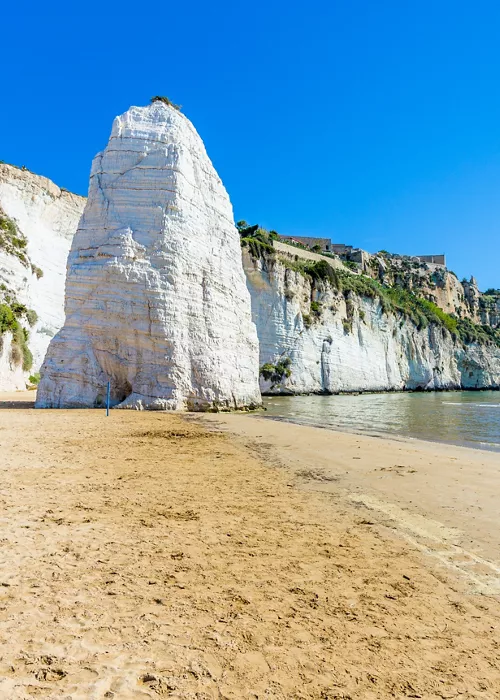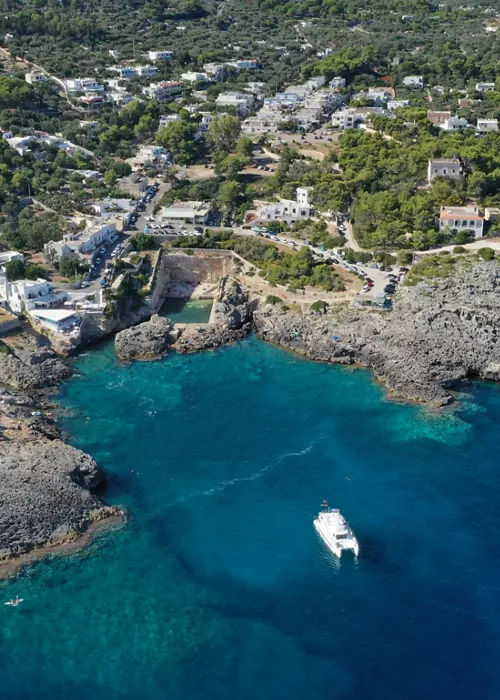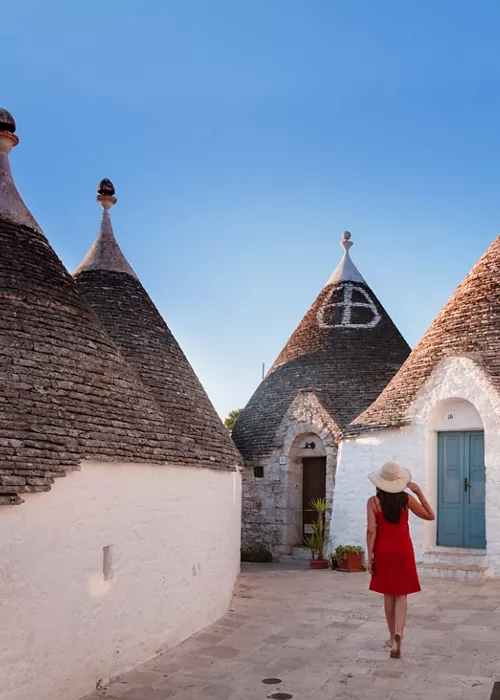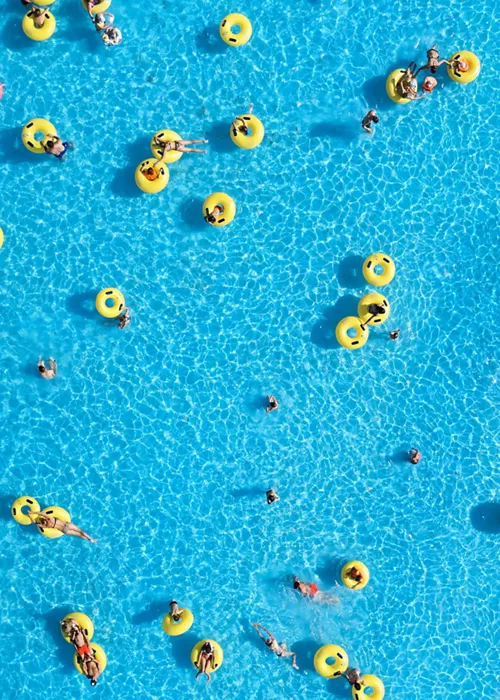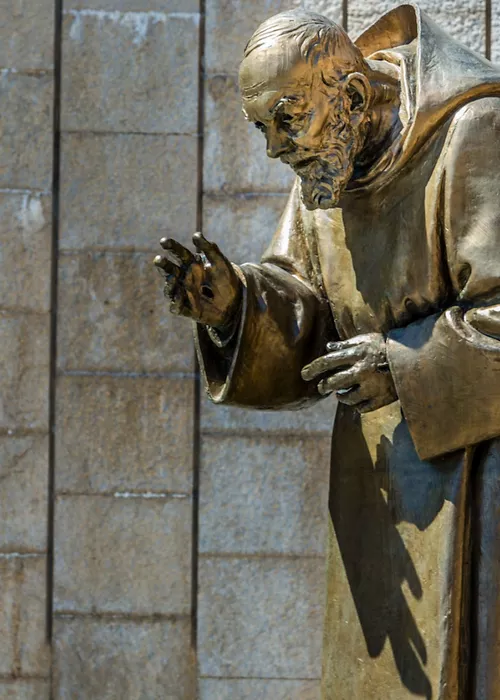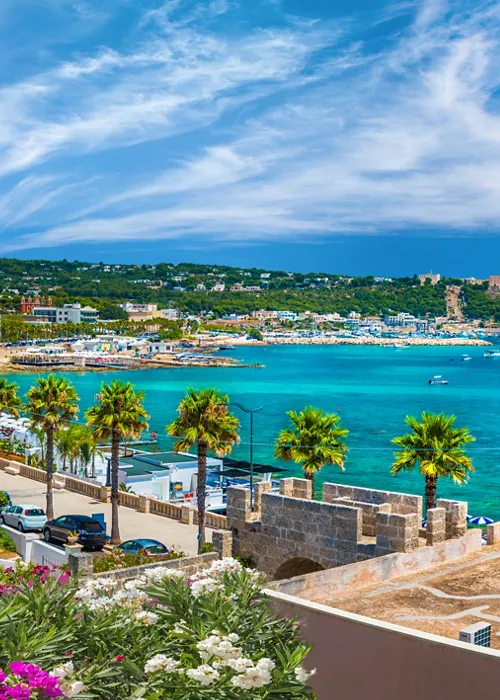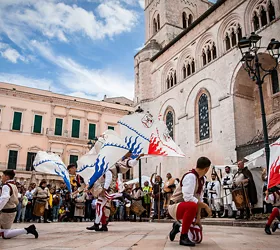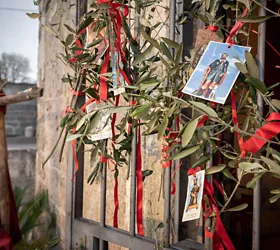Acaya, Archaeology, and a Beach: A Day Trip in Eastern Puglia
9 minutes

Puglia is famous for its stellar coastline, with bronzed bodies on beaches, colourful parasols in busy lidos, and drippings of la dolce vita a common sight all the way from Bari to Brindisi and beyond in summertime.
Yet, in a cluster by one of the most famous beaches of the southern Italian region, two important historical sites linked and shaped by a common cause of threats and opportunities arriving from the eastern coast, have been reevaluated, restored, and rejuvenated as places of interest.
The Fortified Village of Acaya

Acaya, halfway between the Adriatic Sea and the city of Lecce, is one of few remaining fortified villages in Puglia.
Very small, with a permanent population of just 500 people, most traffic comes from passing cyclists on multi-day excursions and day trip tour groups stopping by to understand and appreciate the long-term but short-lived vision of Gian Giacomo dell’Acaya.
Top 5 things not to miss
- Visit Acaya Castle
- Head out on a countryside cycle route
- A traditional lunch
- A guided walk in the Le Cesine WWF nature reserve
- A round at the golf course
Repeated attacks and the Ottoman sacking of Otranto in 1480 led to a full-scale reappraisal of Puglia’s military defences by the Holy Roman Emperor Charles V.
The village of Segine was identified as a potential bulwark to incursions.
The village and wider fiefdom had been under the control of the Acaya family since 1294, and the royal military architect scion of the dynasty - Gian Giacomo dell’Acaya - was the ideal candidate to develop a new type of fortress amongst the fields and olive groves.
Giacomo's vision wasn't simply defensive but rather, in the spirit of the Renaissance, to create an idealised, modernised version of a fortified hamlet: impregnable and capable of sustaining itself through sieges, creating industry and growth, but also serving the needs and livelihoods of its rural population.
Streets were designed to run north-south and east-west in a consistent, parallel block pattern of straight lines and right-angles. The village was enclosed by strengthened surrounding walls, with strategically-positioned bastions. The castle, built by Giacomo's father, was redesigned and reconstructed into a trapezoid structure in a corner of the village - rather than at its centre - with jutting-out sharp angles, a moat, walkways, circular towers, weapon-ready loopholes, and ramparts.
Works were completed in 1536, and the citadel was renamed Acaya.
A subsequent period of prosperity followed, and Giacomo's architectural achievements nabbed him the commission for strengthening many other strategic locations in Puglia.
The good fortune of anything bearing the name Acaya would however be short-lived.
Giacomo would end his days in the dungeon of another castle of his own design in Lecce in 1570, impoverished and imprisoned for debts. The village of which he was both owner and figurehead was sold in the same year, and its decline in importance and wealth was rapid.
For today's visitor, it's far easier to penetrate Acaya's defences through the Porta di Acaya than Giacomo planned! After a long period of neglect, the squat castle has undergone tasteful and extensive renovation works in the last two decades, and now hosts temporary exhibitions and cultural events.
Visitors can access its interior rooms, rooftop and subterranean sections, and there are Italian, English, and French explanations scattered around. Entry is €5, but note that you have to plan ahead around the castle's quite specific opening days and hours, which alter according to the time of year.
After the castle, it's worthwhile to take a little time to explore the quiet, planned streets of single-storey homes and little piazzas - it looks quite unlike most other historic villages and towns you’ll visit in Puglia.
There are only a handful of businesses in Acaya, so options may be limited during your visit to a single cafe and a single restaurant; we had an excellent lunch of the local swordfish and pasta specialty.
The Archaeological Site of Roca Vecchia

It’s a short drive through the countryside to go from the architect to the archaeologist.
In a small peninsula twenty kilometres north of Otranto, in the very place where hundreds would come each day to jump, dive, and leap into a photogenic swimming hole, mysteries are being uncovered and new stories revealed about a very, very ancient people.
As a result, one of the most Instagram-famous locations in Puglia has undergone a significant change to create the region's newest and most prominent archaeological sites.
Top 5 things not to miss
- Explore both sides of the complex
- The Grotta della Poesia (Poetry Cave)
- A guided tour of the ruins
- Walk the coastal path
- Grab lunch in nearby San Foca
Visit just a few years ago, and it would have been difficult to distinguish this part of rocky shore and short cliffs from others you'd pass on the Adriatic Coast.
In fact, unless you knew where to go or what was once here, it would have been easier to drive past on your way to several popular beach towns nearby.
Then, word got out and pictures went viral about one of the most beautiful natural swimming holes in the world and, in lockstep with Puglia's rising popularity amongst non-Italian tourists, Grotta della Poesia became a must-visit spot on itineraries.
However, such fame and footfall rang alarm bells for those who valued the site for a very different reason.
Back in 1983, the collapse of a sea cave roof here triggered the curiosity of Professor Cosimo Pagliara, enabling his discovery of walls covered with inscriptions and etchings from distinct and disparate civilisations. His discovery, in an area that had already been subject to archaeological enquiry, kicked off further excavation works of the large complex now known as Roca Vecchia.
Situated in a strategic corridor of the Adriatic Sea, just 70km across the water from the shores of Illyria (parts of Albania, Croatia and Bosnia and Herzegovina today), the extensive evidence uncovered shows that Roca Vecchia would have been an important place of sanctuary, trade, and cultural exchange for those navigating the central Mediterranean and arriving from Greece. Inhabited from the Neolithic Age (at least two millennia BC) to the second century BC, it is regarded as one of the most important protohistoric locations in Italy.
Although University of Salento teams have undertaken methodical work here for over a quarter of a century since Pagliara's cave discovery, concern at the ever-increasing crowds each summer coming to swim and sunbathe in the Grotta della Poesia and elsewhere within the thirty-hectare site saw decisive action taken in 2019: Roca Vecchia was gated, ticketed, and transformed into a protected archaeological site for continued digs, academic research, and visitors.
The intervention, banning swimming and sunbathing, aims to preserve cultural heritage and deter further damage or loss from erosion and human touch.
Visitors are instead encouraged to contemplate the 3,500 years of uninterrupted settlement here on a flat, beautiful rocky outcrop on the east coast of Puglia, mere steps from the sea. Split across two areas we recommend you first stop by Grotta dell Poesia, Grotta della Poesia Piccola, the Madonna of Roca Vecchia tower, and the fort which formed part of Charles V's coastal defence efforts before walking along to the larger area which houses the foundations and ruins of Bronze Age fortifications and Messapic walls.
We highly recommend taking advantage of the daily guided tours, included in the entry ticket, in order to bring the site to life and add the necessary historical context.
The Beach Town of Torre dell'Orso

Given that there are no shortage of swimming spots on this part of the coastline, efforts to claw back and respect an enclave of such historical interest should be applauded.
So, although it's no longer possible to dive into Grotta della Poesia, you still have excellent options nearby; the beach and village of Torre dell'Orso, less than 3 kms south from Roca Vecchia, is the ideal place for some downtimes before or after your dip into the past in Acaya and Roca Vecchia.
Top 5 things not to miss
- The Observation Point on Via Bellavista
- Enjoy Torre dell'Orso Beach
- Sweet treats from the cafes
- The 'Due Sorelle' panorama at sunset
- Head out on a kayak tour
Fringed by pine forest, and enclosed by cliffs on both sides, the long stretch of sandy beach at Torre dell'Orso - so named for the old watchtower overlooking the shore - ranks as one of the best beaches in Puglia, with the village itself a popular holiday base.
The beach and town share the name and there are several lidos to choose from if you're looking to rent a parasol and a chair for a full day of relaxation (there are also limited areas of free public beach).
Watersports are popular - including kayak hire, adrenaline fueled banana boat adventures and even wakeboarding - and the conditions for swimming here in the azure waters are generally excellent, but on days where the wind picks up, you may also be able to surf and bodyboard!
The new village itself, with a good range of cafes, bakeries, and restaurants, is compact and activity is largely centred around the comings and goings of holidaymakers and day trippers. There are several excellent options on Via Filippo Turati for street food or dinner, and we recommend enjoying the sweeping view of the beach from one of the benches by the viewpoint on Via Bellavista, or with a cocktail at the open-air bar.
The sea stacks known as the Due Sorelle (Two Sisters) are an obligatory photo stop for visitors to Torre dell'Orso, but most don't know the harrowing legend that bestowed the name. The story goes that one of two sisters became so mesmerised by the water that she leapt in, but quickly came into difficulty. Her sister tried to rescue her, but the current proved too strong for both of them. The god of the sea, shocked and repentant at having taken the lives of two innocents, transformed the sisters into the twin rocks, giving them eternal life together.
Aside from the photo opportunities, particularly stunning at sunset, the Due Sorelle viewpoint is also a pleasant, scenic spot to walk along the coast.
You can reach the Due Sorelle on foot from the beach of Torre dell'Orso, though it's a bit of a steep walk up uneven ground. Alternatively, you can drive and park up at the car parks behind the trees, which are very close to the panorama.
Other nearby beaches that are well worth a visit are I Faraglioni di Sant Andrea and the beautifully wild Baia dei Turchi.
If visiting outside of the summer months, consider adding the abandoned medieval village of Borgo Rinascimentale di Roca Nuova to your itinerary. Remarkably well-preserved despite the passing of several centuries, it’s just a 7-minute drive from Torre dell’Orso.
Alternatively, for those that prefer nature over history, the WWF Riserva Naturale Le Cesine would be a wonderful addition. A superb spot for twitchers, this 348-hectare protected natural reserve is a haven for birds, including flamingoes, and other native trees, flora, and wildlife. The reserve can be visited every day of the year in the company of an official guide, with reservation prior to arrival highly recommended.
Useful Information
Best Time To Go
Torre dell’Orso is a popular choice in the peak summer months of July and August, but the weather conditions are still good enough for beach days from May to June and September.
For those of you who really wish to take their time in open-air Roca Vecchia, visiting in the cooler shoulder season months may allow you to appreciate the details a little more than in the intense summer heat.
How To Get There
Acaya is just 20 minutes by car from the city of Lecce or 40 minutes from Otranto, so combining Acaya, Roca Vecchia, and Torre dell’Orso is an excellent idea for a day trip in this popular part of Puglia.
By car, it’s about 20 minutes between Acaya and Roca Vecchia, with Torre dell’Orso less than 5-minutes from the latter.
Alternatively, linking together the three on a day of cycling would be a wonderful, slow way to experience the historical sites as well as the Puglian coast and countryside, and there are specific cycle trails between Acaya and the coast.
Article written about the experience of Andrew and Emily from Along Dusty Roads.
Author: Andrew + Emily from Along Dusty Roads


